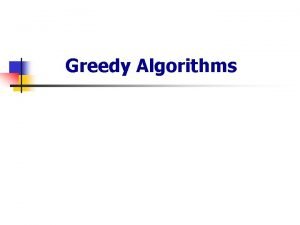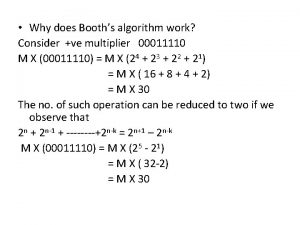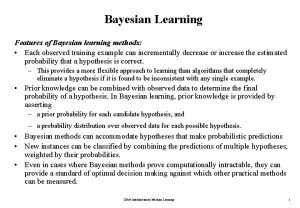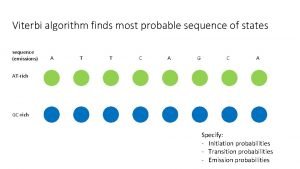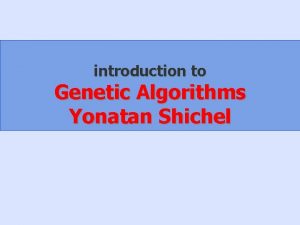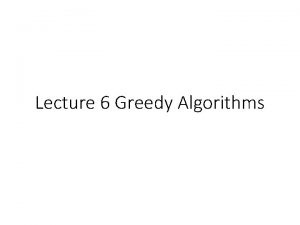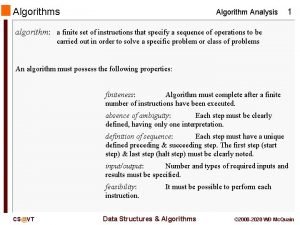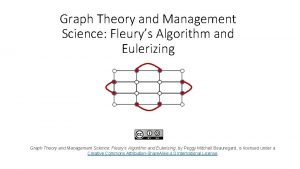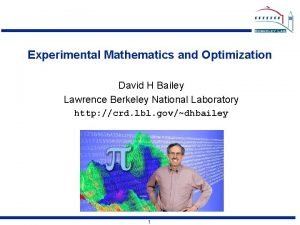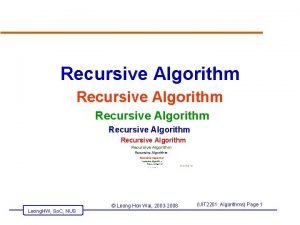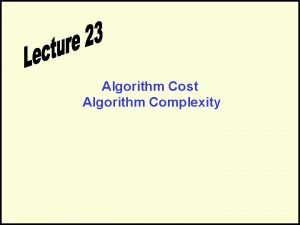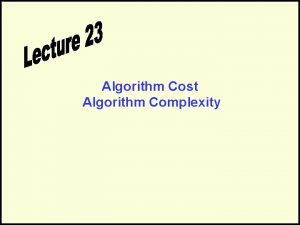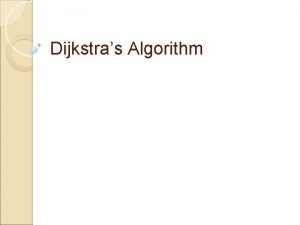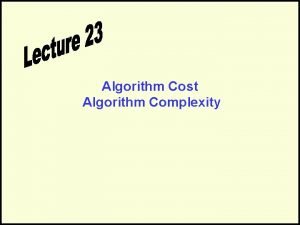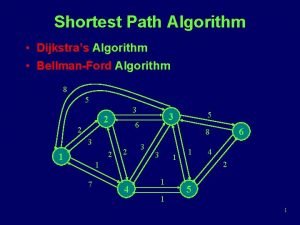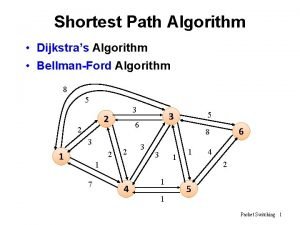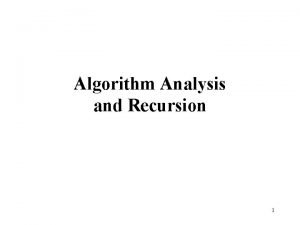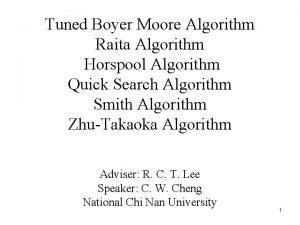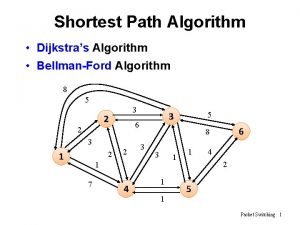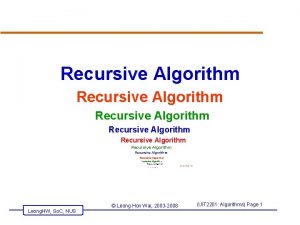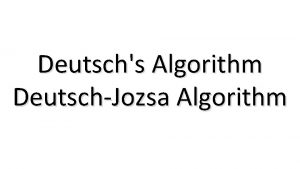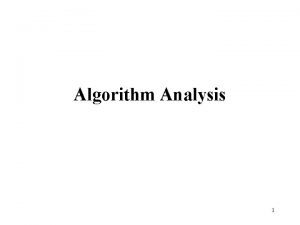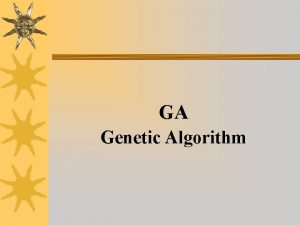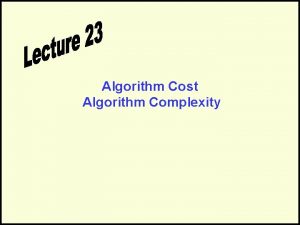What is an algorithm An algorithm is a




![Other methods for gcd(m, n) [cont. ] Middle-school procedure Step 1 Step 2 Step Other methods for gcd(m, n) [cont. ] Middle-school procedure Step 1 Step 2 Step](https://slidetodoc.com/presentation_image/fa798e3ece0bc1f875aa5ab3ed95a854/image-5.jpg)















- Slides: 20

What is an algorithm? An algorithm is a sequence of unambiguous instructions for solving a problem, i. e. , for obtaining a required output for any legitimate input in a finite amount of time. problem algorithm input “computer” output 1

Euclid’s Algorithm Problem: Find gcd(m, n), the greatest common divisor of two nonnegative, not both zero integers m and n Examples: gcd(60, 24) = 12, gcd(60, 0) = 60, gcd(0, 0) = ? Euclid’s algorithm is based on repeated application of equality gcd(m, n) = gcd(n, m mod n) until the second number becomes 0, which makes the problem trivial. Example: gcd(60, 24) = gcd(24, 12) = gcd(12, 0) = 12 2

Two descriptions of Euclid’s algorithm Step 1 If n = 0, return m and stop; otherwise go to Step 2 Divide m by n and assign the value for the remainder to r Step 3 Assign the value of n to m and the value of r to n. Go to Step 1. while n ≠ 0 do r ← m mod n m← n n←r return m 3

Other methods for computing gcd(m, n) Consecutive integer checking algorithm Step 1 Assign the value of min{m, n} to t Step 2 Divide m by t. If the remainder is 0, go to Step 3; otherwise, go to Step 4 Step 3 Divide n by t. If the remainder is 0, return t and stop; otherwise, go to Step 4 Decrease t by 1 and go to Step 2 4
![Other methods for gcdm n cont Middleschool procedure Step 1 Step 2 Step Other methods for gcd(m, n) [cont. ] Middle-school procedure Step 1 Step 2 Step](https://slidetodoc.com/presentation_image/fa798e3ece0bc1f875aa5ab3ed95a854/image-5.jpg)
Other methods for gcd(m, n) [cont. ] Middle-school procedure Step 1 Step 2 Step 3 Step 4 Find the prime factorization of m Find the prime factorization of n Find all the common prime factors Compute the product of all the common prime factors and return it as gcd(m, n) Is this an algorithm? 5

Sieve of Eratosthenes Algorithm for generating consecutive primes not exceeding any given integer n>1. Input: Integer n ≥ 2 Output: List of primes less than or equal to n for p ← 2 to n do A[p] ← p for p ← 2 to n do if A[p] 0 //p hasn’t been previously eliminated from the list j ← p* p //all smaller multiples 2 p, …, (p-1)p are eliminated while j ≤ n do A [j ] ← 0 //mark element as eliminated j←j+p // p*(p+1), p*(p+2), . . . 6

Sieve of Eratosthenes Continues //copy the remaining elements of A to array L of the primes i ← 0 for p← 2 to n do if A[p] ≠ 0 L[i]←A[p] i ←i +1 return L

Sieve of Eratosthenes Continues As an example, consider the application of the algorithm to finding the list of primes not exceeding n=25: 2 2 3 4 5 6 7 8 9 10 11 12 13 14 15 16 17 18 19 20 21 22 23 24 25 3 5 7 9 11 13 15 17 19 21 23 25 3 5 7 11 13 17 19 23 For this example, no more passes are needed because they would eliminate numbers already eliminated on previous iterations of the algorithm. The remaining numbers on the list are the consecutive primes less than or equal to 25.

Why study algorithms? b Theoretical importance • the core of computer science b Practical importance • A practitioner’s toolkit of known algorithms • Framework for designing and analyzing algorithms for new problems 9

Two main issues related to algorithms b How to design algorithms b How to analyze algorithm efficiency 10

Design and Analysis of Algorithm

Algorithm design techniques/strategies b Brute force b Greedy approach b Divide and conquer b Dynamic programming b Decrease and conquer b Iterative improvement b Transform and conquer b Backtracking b Space and time tradeoffs b Branch and bound 12

Analysis of algorithms b How good is the algorithm? • time efficiency • space efficiency b Does there exist a better algorithm? • lower bounds • optimality 13

Important problem types b sorting Two properties: stable and in-place searching b string processing b graph problems Traveling salesman problem, graph-coloring problem combinatorial problems Finding a combinatorial object that satisfies certain constraints geometric problems Closest-pair problem, convex-hull problem numerical problems Example: solving equations, evaluating functions, computing definite integrals and so on b b b 14

Fundamental data structures b list • array • linked list • string b stack LIFO b queue FIFO b priority queue HEAP b Graph G = < V, E > Representation: Adjacency matrix Adjacency list b Tree (connected acyclic graph) b set and dictionary 15

16

A. Levitin “Introduction to the Design & Analysis of Algorithms, ” 3 rd ed. , Ch. 1 © 2012 Pearson Education, Inc. Upper Saddle River, NJ. All Rights 17

18

A. Levitin “Introduction to the Design & Analysis of Algorithms, ” 3 rd ed. , Ch. 1 © 2012 Pearson Education, Inc. Upper Saddle River, NJ. All Rights 19

A. Levitin “Introduction to the Design & Analysis of Algorithms, ” 3 rd ed. , Ch. 1 © 2012 Pearson Education, Inc. Upper Saddle River, NJ. All Rights 20
 Difference between a star and ao star
Difference between a star and ao star Adri wessels
Adri wessels Pseudo code example
Pseudo code example Activity selection problem
Activity selection problem 4-lom conclusion
4-lom conclusion Graph based method layout
Graph based method layout Multiply -5 x-2 by using booth algorithm with flowchart.
Multiply -5 x-2 by using booth algorithm with flowchart. Brute force map learning algorithm
Brute force map learning algorithm Design of an absolute loader
Design of an absolute loader Attc coin
Attc coin Solid area scan conversion
Solid area scan conversion Single point crossover in genetic algorithm
Single point crossover in genetic algorithm Cellular ost
Cellular ost Nrp algorithm
Nrp algorithm Algorithm font
Algorithm font Algorithm analysis examples
Algorithm analysis examples Line in computer graphics
Line in computer graphics How about now
How about now Digital algorithm
Digital algorithm Pslq algorithm
Pslq algorithm Algorithm
Algorithm



